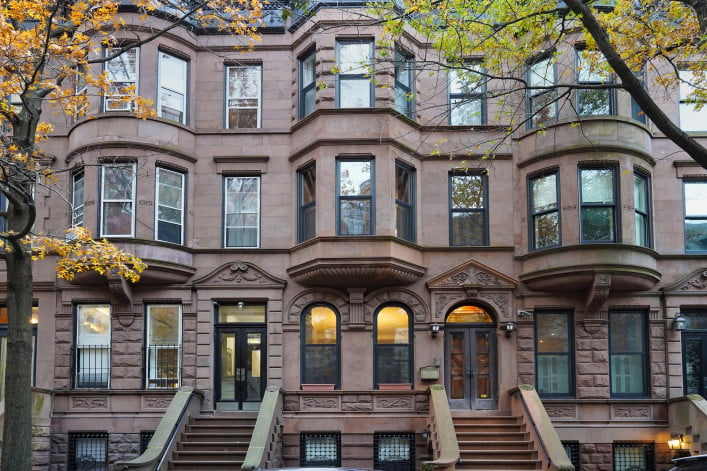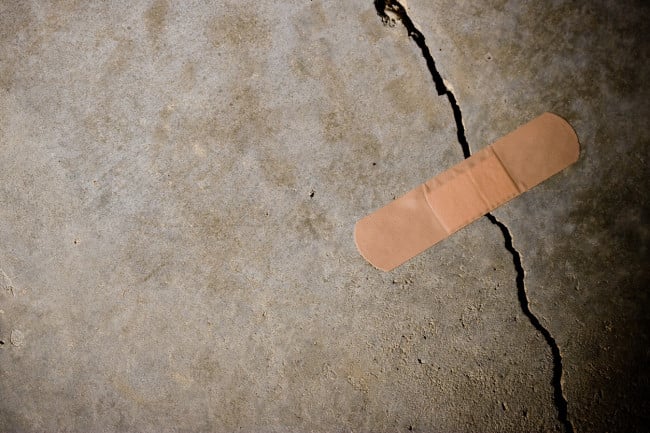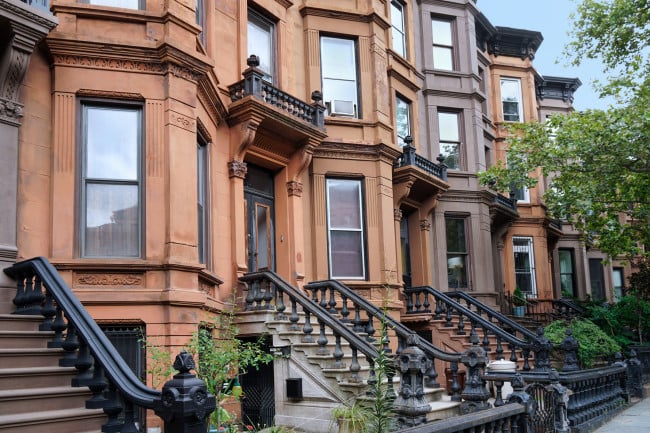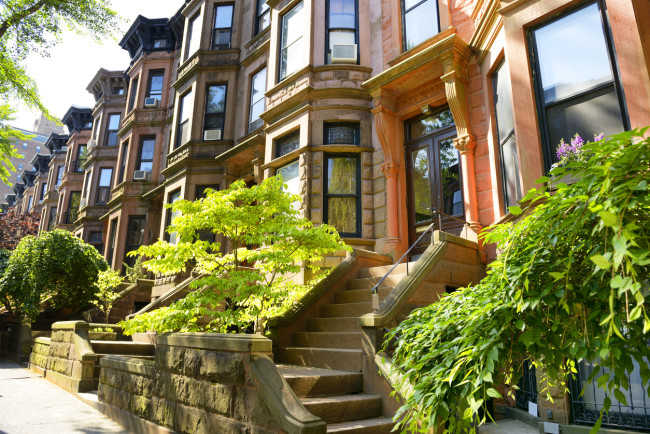A home inspection checklist if you are buying a NYC brownstone
- Consider making the offer contingent on the home inspection—and get it done as soon as possible
- Common concerns include the facade, foundation, structure, roof, plumbing, electrical, and HVAC
- If problems are discovered ask the seller to address them or negotiate for a credit

The iconic brownstone facade and stoop are among the main focal points of a pre-purchase home inspection.
peterspiro via Getty Images
Buying a brownstone comes with lots of perks, but that coveted square footage, privacy, and outdoor space comes with added responsibility. Unlike in a co-op or condo, you have to handle all the maintenance and upkeep––from top to bottom, inside and out, and all the systems that keep your home running smoothly.
That's why getting a pre-purchase inspection for a brownstone is essential in discovering existing issues and identifying potential problems that might only crop up after closing on the deal. Otherwise, you might be on the hook for having to repair or replace a faulty boiler or crumbling facade—and why you may want to consider making an offer contingent on the property passing the site inspection. (Though Jessica Buchman, a broker with Corcoran, says an inspection contingency isn’t needed. "The reality is if something unsurmountable turns up, the buyer will not move forward with the deal.")
"Generally, it is much more important to have a professional inspection of a townhouse prior to signing a contract of sale than for a condo or co-op," says closing attorney Adam Stone, a partner at The Stone Law Firm. (Though getting those properties inspected is also helpful.)
"Buying a townhouse is similar to buying a house in the suburbs in that the owner is responsible for everything, including the roof, foundation, and all building systems. There is no co-op or condo board to take on any of this responsibility. There is no reserve fund to use for repairs. There is no superintendent to call in, unless you hire one yourself," he says.
Kenneth Lee, owner of Brooklyn-based Green Apple Home Inspection, brings up another common issue with brownstones—their age and history of (sometimes) hodge-podge renovations.
"Most of these buildings have undergone multiple changes over the past century and their conditions run the gamut, but with few exceptions, they can be made into wonderful living spaces," he says. (Side note: His ancestors built brownstones back in the day, including his great-great-grandfather's home on Keap Street in Williamsburg that's still in use today.) He shares some of the more common issues he has seen in his decades of experience below.
But first, some helpful tips to get you started on your home inspection journey.
How to find a qualified inspector
"Always, always, always make sure you have a reputable and competent inspector come look at the house, says Ellen I. Sykes, a broker at Coldwell Banker Warburg—emphasis on reputable/competent.
The inspector should be licensed by the state. (Scroll down to search by individual or business name.) It’s also a good idea to work with someone who is experienced with brownstones, which have a whole set of potential problems not associated with modern buildings.
Word-of-mouth referrals from friends and neighbors are better than those from a broker (to avoid a potential conflict of interest). Or you can search through the American Society of Home Inspectors and the National Association of Home Inspectors.
Lee recommends choosing an inspector who has Errors and Omissions Insurance in addition to General Liability. "That proves just how serious the inspector really is."
How much it will cost
As with all things real estate, the inspection fee can vary greatly depending on the size and condition of the property. But $750 to $1,000 is a ballpark average starting point.
When to have an inspection
The general consensus is—as soon as you can after making the offer.
That's especially true in a buyer's market when you might be competing with other buyers and time is of the essence.
As for waiving an inspection to beat out those other buyers, Stone says he would never recommend this. "Without an inspection, there is no way to know the condition of the building, the useful life of the systems, or the safety and code compliance of any improvements."
And if (as often happens) the inspection turns something up, you can ask the seller to address any concerns—or to at least negotiate for some of them or for a credit, Stone says. "The seller’s willingness to take on any repairs will often depend on the state of the market and how much leverage either the seller or buyer has."
For example, one of his recent clients had a pre-contract inspection done on a house where the roof needed repairs in the very short term. The potential buyer was able to bring in a roofer for an estimate, which turned out to be around $50,000. So the buyer was able to amend the offer and negotiate a good portion of that expense to be covered by the seller.
Buchman says it takes some finesse to ensure a positive outcome for both parties. "Goodwill is easily damaged when a buyer tries to renegotiate after a poor inspection." She always suggests that buyers factor in some unknowns when they make their initial offer. If something big and expensive turns up at an inspection, she encourages the buyer to get an estimate on what it would cost to remediate or fix the issue. "Then, depending on the spirit of the deal ,we will go to the seller and ask them to share the expense with us—90 percent of the time, the seller will make a contribution. "
Even if the buyer cannot get the seller to agree to any repairs, "at least the buyer goes into the transaction with eyes wide open," Stone says.
The following checklist walks you through the most common concerns so you know what to expect—and what to ask if the inspector misses anything.
1. Exterior facade
Despite being the first thing you see in a brownstone, Monisha S. Rana, an agent at Coldwell Banker Warburg, says the facade often doesn't come to mind when talking about inspections. "Yet that sandstone facade is very porous; therefore, both its appearance and structural integrity can be compromised due to environmental factors, age, and natural wear and tear."
Or as Lee explains it, "Over time, this surface can delaminate, meaning the outer layers can flake off."
So a home inspection will help you determine the integrity of the façade and let you plan for future maintenance, Rana says, adding that you'll want to factor the (potentially six-figure) cost of any repairs into your payment price.
Lee points out that proper repair is also labor-intensive and will most likely require permits, which can become even more difficult to obtain if the property is landmarked. What's more, when inspecting the exterior, you want to make sure all attached terraces, decks, railings, steps, and stoops are intact, stable, and well-maintained.
2. Basement/cellar (aka foundation)
According to Lee, most brownstones have stone and mortar foundations; after 100-plus years, much of the mortar between the stones may have deteriorated into sand. "This facilitates a path for moisture to enter the basement or cellar."
He says to be especially careful of fully finished basements or cellars, as the drywall can hide foundation issues. "A good inspector will come equipped with a thermal imaging camera to help identify moisture intrusion, but even with the latest tools, it is not a foolproof process."
Karen Kostiw, an agent at Coldwell Banker Warburg, points out that musty smells and a damp floor and walls are other indicators of water issues, so an inspector will make a note of those types of observations along with testing sump pumps and the condition of French drains if they are present. How the home is sloped also matters when it comes to proper drainage.
Other factors can threaten to compromise the foundation, too. Kate Wollman-Mahan, another agent at Coldwell Banker Warburg, says people often underestimate the extent and complexities involved in maintaining a brownstone. "I took a buyer to a West Chelsea townhouse that had a beautiful garden with a large flowering tree. But, the buyer didn't realize that the tree roots were so overgrown that they were actually damaging the pavers and possibly impacting the foundation.
3. Water infiltration
The basement or cellar is not the only space that can be penetrated by water.
Kostiw says an inspector will take a close look at the building's entire envelope, from the roof and attic and down the side walls to the foundation. "Water issues can rot insulation and damage a home quickly. Even a washing machine missing a drip pan can cause major damage."
"It's crucial to determine if waterways and leaks have compromised the structure in any way. If not, and everything is tightly sealed, then that is a real bonus," says Svetlana Choi, a broker at Coldwell Banker Warburg.
Where there's moisture, there's the potential for mold—something Lee says is all too common in brownstone inspections.
4. Structure
Lee explains that although the exterior of a brownstone consists of stone and brick, the interior structure is wood. And the interior walls of townhouses can have structural properties—an important consideration given that open floorplans are all the rage these days. Most townhouses have a wood frame wall parallel to the staircases that, while not loadbearing like the masonry side walls, serves to transfer the load from the joists to the cellar and then to the ground. "Removing this or any interior wall can have serious structural implications so such work can only be safely done if approved by an architect and/or engineer," he says.
Kostiw also notes that a general inspector will observe a home for any signs of structural stress, including sagging joists, cracks or holes or crumbling walls, and damp sections in the foundation.
Termites are another concern—"once moisture finds its way into the basement/cellar, it is only a matter of time before termites find their way to the floor, joists, studs, etc., causing damage that can seriously undermine the structure," Lee says.
Although not common, Lee says he has been in a few buildings where a cellar was excavated to add additional ceiling height, which unless done correctly can seriously compromise the structural integrity of a building—"and buildings have been known to collapse for this very reason." (For ths reason, broker Svetlana Choi of Coldwell Banker Warburg says buyers who want to increase the height of the basement should carefully explore whether it will be possible and if so, will it be worth the expense.)
Note that an inspector is not qualified to do more than note any findings. An architect or structural engineer may need to further evaluate the property’s structural components.
5. Insulation
The first question is whether there is sufficient insulation in the exterior walls and attic, as this can greatly impact the efficiency of the heating/cooling systems. Insulation is rated in terms of thermal resistance, called the “R-value.” The higher the R-value, the greater the insulating effectiveness.
Even if what's there meets modern-day standards, Samantha Rose Frith, an agent at Coldwell Banker Warburg, says it might contain asbestos, a carcinogen that used to be used for insulation. "Home inspectors will always check for it in old townhouses!"
6. Roof
"The roof is crucial—it is important to determine when it was last replaced and whether it has been maintained," Choi says. If not, then that is a major expense.
According to Kostiw, inspectors are looking for signs of storm damage, gutters that are not working properly, damaged or missing shingles or flashing, signs of trees piercing the roof, and cracks and potential leaks in the chimney. They will also be looking for signs that wildlife or insects have entered the home and created nests."
Lee says roof decks are a common issue. "Everyone loves private outdoor space, but there are quite a number of factors to consider when putting a roof deck on any building, and that goes double for buildings that are over 100 years old." He cites in particular the roof structure on older brownstones, which were not designed to carry the weight of people, furniture, roof pavers, and decking material. Also, since no staircase exists to access the roof, an interior staircase will need to be built, which will likely alter the roof structure. Any recreational space on a roof requires a minimum railing height of 42 inches above the walkable surface. In landmarked buildings, visible railings will likely have to be set back from the edge of the building, reducing the amount of usable space. "Needless to say, the budget for such a project can quickly become huge."
Takeaway: If an existing roof desk doesn't pass muster, you might be in for a costly remediation.
7. Plumbing
Of all the pain points, leaky pipes are something most people can relate to—and kvetch about. But low flow and fluctuating temperatures are other banes of existence for many New Yorkers.
"The inspector should turn on the cold and hot water in sinks and showers and flush all toilets," Kostiw says, adding that interior walls, floors, and ceilings will be observed for any potential visual cracks or damp areas. "One inspection uncovered a water leakage issue due to improper installation of molding, which pierced a pipe. Most issues can be resolved, but best to find out the issues early and resolve them before a large issue is created."
You'll also want to check for lead supply or distribution lines in the house. "It is well known that lead is hazardous in potable water, and due to the age of these buildings, it is not uncommon to find lead pipes in brownstones."
8. Electrical wiring
Keep in mind that most of these buildings were built without any electricity and have likely been updated multiple times, though not necessarily to modern standards. According to Lee, all outlets should be properly grounded, GFCI (ground fault circuit interruption) outlets should be installed near a water source (kitchens, bathrooms, laundry rooms, outdoor spaces), and circuit breakers should be utilized in the electric panels, which should be no more than 25 years old. (Watch out for certain brands of electrical panels, such as Federal and Pacific, that are known to be defective.) Also, old-school, cloth-covered wiring should be replaced with modern wiring. Finally, and importantly, these properties are often underpowered for current energy demands.
Kostiw stresses that GFCI outlets are required to prevent electric shocks if there is a current-flow interruption or the presence of water. In addition, GFCI's should be present for outdoor electric outlets and encased in a waterproof outside electric box.
9. HVAC systems
"By now, the original heating and hot water systems in brownstones have all been replaced, although not necessarily recently," Lee says, adding that most heating and hot water equipment in these buildings utilize gas and/or oil. If these systems are in the basement/cellar, which is most common, it is important that air ducts are installed to properly ventilate to the outside.
You'll also want to make sure the boiler is well maintained, Frith says. "Has the boiler been converted to gas or is it still oil? (This is not essential, but gas is cheaper!)"
In Kostiw's experience, an inspector will look to see if the owner has been keeping up with routine maintenance (noted on the mechanism) and other problems. Is a room not heating up? Does the system smell of gas or other odor when testing it? Is the thermostat working—including multiple zones controlled by an app? Homeowners often forget to change filters every six months, leaving signs of dirt and clogs in the system.
Choi points to the condition of the boiler and water heater. Even if there is a good amount of life left in the units (10 years is a good benchmark), it might be worth putting in new systems, particularly if you want to incorporate a greener footprint.
Sykes says to look at the water tank: What size is it? Can it handle a whole house, or is it undersized? Is there rust coming from the safety valve or dripping?
10. Windows and doors
All windows should be checked to see if the mechanisms function properly; double-hung windows should remain open on their own and show no signs of condensation on the inside.
Kostiw says inspectors will also look for rotting wood and signs of water seepage in the window frames and trim.
Exterior doors should have weatherstripping and latch properly, again to prevent drafts and for safety. Interior doors should open and shut properly, too, with working knobs and hinges.
11. Flooring
Is it level? Is the material in good condition?
Kostiw says common issues include signs of moisture, gaps, cracks, loose boards, excessive staining, and insects/pests, and that the inspector will test all floors with radiant heating to ensure they are working properly.
12. Kitchen and bathrooms
The biggest concern here is making sure the exhaust fans (including for a gas stove) are vented to the outside, along with checking the condition of tiles, caulking, and sink/tub/shower drainage.
Also, do all toilets flush and fill properly? Are they stable? Any signs of leakage around the base?
13. Appliances
It's common practice for the inspector and prospective buyer to take photos of each appliance's serial number and the name of the manufacturer, Kostiw says, and then to use that information to determine the age and if the warranty is still in effect.
Be sure to test all appliances—washers/dryers, stoves/ovens, microwaves, refrigerators, dishwashers, and window-unit air-conditioners. A gas dryer must also be appropriately vented.
14. Safety detectors
Are smoke detectors and carbon monoxide detectors in working order and located in all the requisite spots?
15. Grounds
What you don't want to see: standing water, especially near the house or on any paving. That's a sign of improper drainage.
Choi suggests checking to see if the walls and any decking are in good shape.
Per Sykes: "Check for overhanging tree branches from an adjoining property—are they going to fall down on your terrace or backyard?" The same goes for your own trees, which shouldn't touch the roof.
And Frith suggests investigating the garden for signs of rodent infestation. "I’ve had a rat's nest in my garden for over a year now, and no one can get rid of it. They keep coming back. I’m having to concrete the entire backyard now and rip up all my plants."
Proof that sometimes, even the choicest perk becomes a pesky concern.
You Might Also Like




























